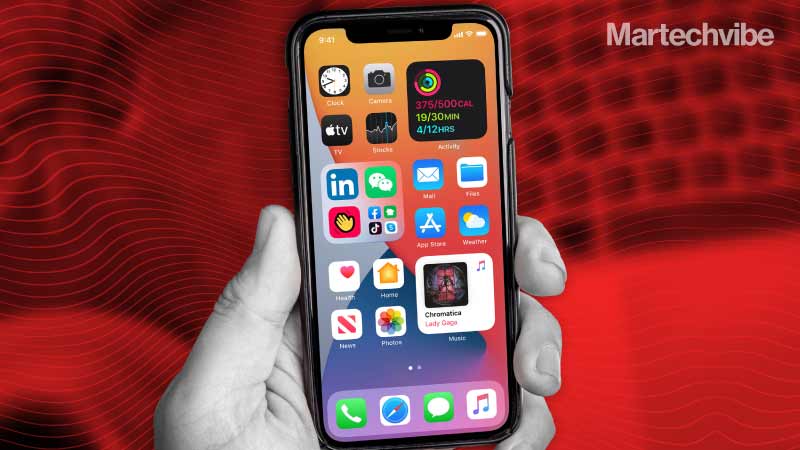Apple’s iOS 14 Privacy Features — Three Tips To Win The Opt-in Game
Any doubt that we are entering a privacy-first era was dispelled when Apple announced the security features of its iOS 14, which came into effect in April 2020. A watershed moment for marketers and app developers as Apple’s App-tracking Transparency (ATT) framework now requires users to actively grant access permission to their device’s Identifier for […]
Topics
What to Read Next
- Martechvibe Launches the Marquee Awards to Celebrate Breakthrough Digital Campaigns
- Top Marketers 4X More Likely to Use AI, Consolidate Tech
- Roku and iSpot Bring Outcome-Based Optimisation to Streaming
- PMG Expands Influencer Marketing Capabilities with Acquisition of Digital Voices
- PayPal Ads Launches Transaction Graph Insights & Measurement

Any doubt that we are entering a privacy-first era was dispelled when Apple announced the security features of its iOS 14, which came into effect in April 2020. A watershed moment for marketers and app developers as Apple’s App-tracking Transparency (ATT) framework now requires users to actively grant access permission to their device’s Identifier for Advertisers (IDFA).
While this is a positive move from a privacy perspective, it has presented challenges for marketers and app developers when it comes to measuring and analysing campaign performance, app monetisation, and the ability to provide a personalised user experience.
Indeed, leading up to the changes, estimates as to the actual rate of users that would opt-in to sharing their IDFA varied from 0-20 per cent, and many anticipated financial losses as a result.
However, in the Middle East, there is cause for optimism, because data suggests that approximately 54 per cent of users have currently opted in.
This is great news for marketers and developers in the region, but there’s clearly room for improvement, so here are some practices that can increase the opt-in.
Also Read: Reinventing Display Advertising for 2019
Build trust in the ATT prompt
While Apple is open with users about what activity may be tracked by apps when displaying the user prompt (also known as the ATT prompt), developers (and perhaps more importantly, marketers) can customise an accompanying piece of text.
So, while Apple tells users that an app may track users across third-party apps and websites, the purveyor of the app gets the opportunity to make its case and clarify its policy on device data, while being under no obligation to use words such as “track” or “monitor”. Organisations can tell users if their data will only be used to improve experiences or if the app vendor does not track users outside its corporate domain, thereby garnering trust among potential opt-ins.
When customising the prompt — known as the “ATT purpose string” — enterprise marketing teams can talk of benefits and allay fears about how data is collected, stored, and used. Curated experiences that enhance the utility of the app can be at the center of the message, which can stress benefits such as individualisation, ad relevance, and security.
Marketing professionals may not be aware of many of these features and developers may not have the consumer-empathy skills to communicate them effectively, so these teams must work together closely on the crafting of the purpose string. The trust and confidence of consumers (and hence their likelihood to opt in) are at stake, so teams must create messages that are short, positive, and focused on what advantages opting in can bring to the user.
Also Read: How are Industry Leaders Reimagining Marketing in 2021?
Prepare users with native messaging
The ATT prompt is not the only opportunity to communicate opt-in value. Apple allows the app developer to decide when the prompt is displayed and places no restrictions on app-native messaging before the all-important display of the ATT prompt itself.
The design, message, and timing of these prompts is entirely up to the app vendor. Developers and marketers can prepare users for the ATT prompt and make them more receptive to the upbeat, customised part of the purpose string than to Apple’s stern warning. Then developers can place a call-to-action button labelled “Continue” or “Next” to lead users to their ultimate decision. It is best not to label this button “Allow”, as users that press it may mistakenly think they have already opted in. It is also worth pointing out that Apple has taken measures to prevent any material incentivisation within the process — including discounts and extra functionality — that are contingent upon opt-in.
Also Read: A Token of Ad-ppreciation
Consider the timing of the ATT prompt
Control about when they show the ATT prompt is a major arrow in developers’ quivers. AppsFlyer benchmark studies have shown that there is an optimal time to solicit user opt-in. App engagement rates increase with usage, but user bases can shrink over time, with an average Day-Seven retention rate of as low as 10 per cent. Waiting too late in the user journey also stretches out the time to value users for marketers.
When considering the timing of the ATT prompt, remember that Apple allows the display of a post-ATT prompt with a further opportunity for user opt-in. Developers can show it as many times as they like. However, decisions on this practice should be weighed against quality of experience. And developers and marketing teams should also seek to build trust further by informing users that they can disable permissions at any time. Between each ATT reminder prompt, marketers can continue building brand trust and engagement with users, in time converting more and more opt-outs to opt-ins.
It’s easy for app developers and marketers to be intimidated by iOS 14 and its new privacy features. However, they should find confidence in the fact that they aren’t without options. With the right message, framed well and delivered at the optimum moment, opt-in rates can be lifted to where they need to be for effective attribution.
*Samer Saad is the Regional Manager – Middle East, AppsFlyer









































































































